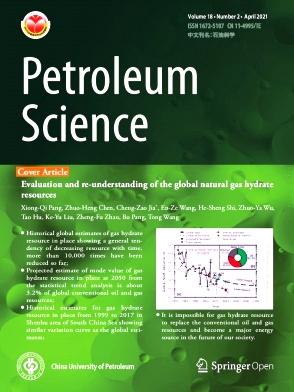Microscopic occurrence and distribution of oil and water in situ shale: Evidence from nuclear magnetic resonance
IF 6
1区 工程技术
Q2 ENERGY & FUELS
引用次数: 0
Abstract
Characterizing the microscopic occurrence and distribution of in-situ pore water and oil is crucial for resource estimation and development method selection of shale oil. In this paper, a series of nuclear magnetic resonance (NMR) experiments were conducted on shales from the Gulong Sag, Songliao Basin, China, at AR, WR-AR, WOR-AR, Dry, SO, and WR states. In-situ pore water and oil were reconstructed after WOR-AR. An improved T1–T2 pattern for shale oil reservoirs comprising water and oil was proposed to classify and quantitatively detect pore fluids at different occurrence states. The total and free oil contents derived from NMR T1–T2 spectra at AR states were found to correlate well with those from multistage Rock-Eval. Moreover, the NMR-calculated total and free oil are generally larger than those measured from multistage Rock-Eval, whereas adsorbed oil is the opposite, which implies that adsorbed, bound, and movable oils in shale pores can be accurately and quantitatively detected via NMR, without absorbed hydrocarbons in kerogen. As per the NMR T2 and T1–T2 spectra at WOR-AR state, the microdistributions of in-situ pore water and oil were clearly demonstrated. Adsorbed, bound, and movable oils primarily occur in the micropores (<100 nm), mesopores (100–1000 nm), and macropores (>1000 nm), respectively, whereas capillary-bound water is primarily correlated with micropores. Thus, the microscopic occurrence and distribution of adsorbed oil are remarkably affected by pore water, followed by bound oil, and movable oil is hardly affected. This study would be helpful in further understanding the microscopic occurrence characteristics of pore fluids in-situ shale oil reservoirs.
油和水在原位页岩中的微观发生和分布:核磁共振的证据
本文章由计算机程序翻译,如有差异,请以英文原文为准。
求助全文
约1分钟内获得全文
求助全文
来源期刊

Petroleum Science
地学-地球化学与地球物理
CiteScore
7.70
自引率
16.10%
发文量
311
审稿时长
63 days
期刊介绍:
Petroleum Science is the only English journal in China on petroleum science and technology that is intended for professionals engaged in petroleum science research and technical applications all over the world, as well as the managerial personnel of oil companies. It covers petroleum geology, petroleum geophysics, petroleum engineering, petrochemistry & chemical engineering, petroleum mechanics, and economic management. It aims to introduce the latest results in oil industry research in China, promote cooperation in petroleum science research between China and the rest of the world, and build a bridge for scientific communication between China and the world.
 求助内容:
求助内容: 应助结果提醒方式:
应助结果提醒方式:


